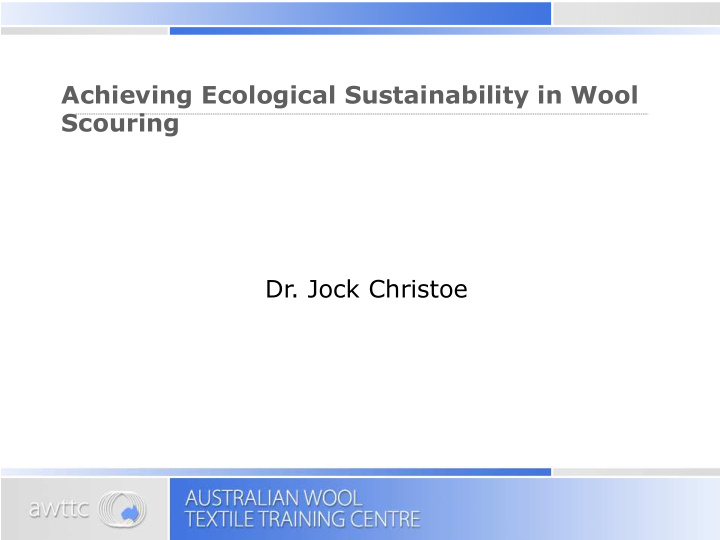



Achieving Ecological Sustainability in Wool Scouring Dr. Jock Christoe
Problems with Scouring Effluents Organic load § Biorefractory nature of wool wax § Pesticide residues § Detergent residues § Potassium levels §
Contaminants on Wool COD on COD Amount wool (g/ on wool factor kg) wool 15% 2.97 446 wax suint 5% 0.83 41 dirt 15% 0.65 98 total 585
Drivers for Change § Regulatory § Market § Economic
Regulatory Approach Chinese NEPA
China NEPA Regulations Chinese Regulations COD 100 ppm BOD 25 ppm Colour 40 dilutions pH 6 - 9 Suspended Solids 70 ppm
Discharge to Surface Waters NEPA REGULATIONS COD on wool COD in effluent (g/kg) (ppm) No treatment 565 56,500 With wax recovery 431 43,100 (30%) Chemical 60 6,000 (95%) Biological 5 500 (90%)
Meeting Chinese Regulations Chinese Regulations § Dilution § Mixing with other effluents § Dyeing / Finishing § Carbonising § Shrinkproofing
Effect of Dilution Chinese Regulations 10 litres/kg 50 litres/kg No treatment 56,500 11,300 With wax 43,100 8,620 recovery (30%) Chemical (95%) 6,000 1,200 Biological (90%) 500 100
Market- Driven EU Eco-label Organic Wool
EU Ecolabels § Requirements § Meeting Requirements
Requirements § Auxiliary Chemicals § Biodegradability § Effluent Discharge
Auxiliary Chemicals § Prohibited Chemicals § Alkylphenolethoxylates (APEO) § Linear alkylbenzene sulphonates (LAS) § Ethylene diamine tetra acetate (EDTA) § Verification § Declaration of non-use
Biodegradability § Definition § ≥ 95% degraded or eliminated in treatment § Verification § Documentation, MSDS, test reports showing test methods and compliance
Effluent Discharge § Sewer Discharge § COD < 60 g/Kg greasy wool § COD reduced by ≥ 75% in off-site treatment § Surface Waters § COD < 5 g/Kg greasy wool § pH 6 – 9 § Temperature < 40 o C § Verification § Data & test report using ISO 6060
Sewer Discharge COD in effluent (ppm) COD on wool (g/kg) 10l/kg 20//kg No treatment 565 56,500 28,250 With wax recovery 431 43,100 21,550 (30%) Sirolan CF (87%) 56 5,600 2,800
Surface Waters COD on wool COD in effluent (g/kg) (ppm) No treatment 565 56,500 With wax recovery 431 43,100 (30%) Chemical 60 6,000 (95%) Biological 5 500 (90%)
Organic Wool § Organic wool production § Organic wool processing
Organic wool production Based on § the harmonious relationship between land, water, plants and livestock § respect for the physiological and behavioural needs of livestock § feeding of good quality, organically grown feedstuffs. § No synthetic pesticides
Organic Wool Processing § Aromatic solvents prohibited § Complexing agents and detergents (APEO, EDTA, LAS) prohibited § Halogenated solvents prohibited § Heavy metals prohibited § Chlorination of wool prohibited § Carding/spinning auxiliaries only paraffin oils and products based on natural products permitted § Metal-complex dyes, chrome dyes and AOX containing dyes are prohibited
Difference between Ecolabel and Organic Ecolabel Organic Pesticides on greasy wool Small amounts allowed prohibited Detergents No APEO, LAS, EDTA As ecolabel Top making chemicals limited Chlorination Only on tops prohibited Heavy metals Small amounts allowed prohibited Effluent discharge to 60 g COD/kg greasy No stated sewer Effluent discharge to 5 g COD/kg greasy Not stated surface water
Economic Driver A Rational Approach
Ecological Sustainability § Waste minimisation § No waste discharges § Contaminants used as a resource
Features of a Rational Approach Ecological Sustainability § Waste minimization § Separation of waste streams § Resource rather than a waste § Integration with scouring process § Modular § One sludge
Waste Minimisation Ecological Sustainability recovered SCOURING RECOVERY wool wax LOOPS reuse WASTE recycle fertiliser TREATMENT treated SLUDGE sludge TREATMENT effluent
Sirolan CF - The Cornerstone to a Rational Approach § Simple § In-line treatment § No mixing tanks § Dry sludge
Ecological Sustainability Sirolan CF in Australia
Option 1 Ecological Sustainability SCOURING SCOURING SCOURING SCOURING RINSING RINSING RINSING RINSING wool wool wool wool contaminant recovery contaminant recovery contaminant recovery contaminant recovery wax wax wax wax Sirolan CFB Recycling Recycling Recycling Recycling Sirolan CF Sirolan CF Sirolan CF Sirolan CF biological biological sludge sludge sludge sludge chemical chemical chemical (wool wax, dirt) (wool wax, dirt) (wool wax, dirt) (wool wax, dirt) biological biological biological compost, compost, compost, compost, fuel fuel fuel fuel effluent effluent effluent
Biorefractory Suint - Effect on COD Removal Ecological Sustainability 1200 1200 400 TOC and BOD 5 (mg/L) 300 800 800 COD (mg/L) 200 400 400 TOC COD 100 BOD 5 0 0 0 100 200 300 Treatment Time (min.)
Option 2 Ecological Sustainability SCOURING SCOURING SCOURING RINSING RINSING RINSING wool wool wool contaminant recovery contaminant recovery contaminant recovery wax wax wax recycling recycling recycling Sirolan CF Sirolan CF Sirolan CF concentration concentration concentration concentrate concentrate concentrate sludge sludge sludge (suint) (suint) (suint) (wool wax, dirt) (wool wax, dirt) (wool wax, dirt) fertiliser fertiliser fertiliser compost, compost, compost, fuel fuel fuel
Potassium Uptake Ecological Sustainability Potassium in Plant Tissue, mg/kg dry Potassium in Plant Tissue, mg/kg dry Potassium in Plant Tissue, mg/kg dry Potassium in Plant Tissue, mg/kg dry 30 30 30 30 25 25 25 25 20 20 20 20 15 15 15 15 10 10 10 10 5 5 5 5 0 0 0 0 Control Control Control Control Potash Potash Potash Potash Suint Suint Suint Suint
SUMMARY
Recommend
More recommend